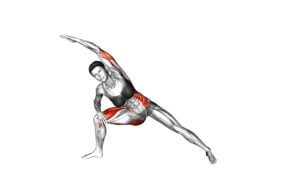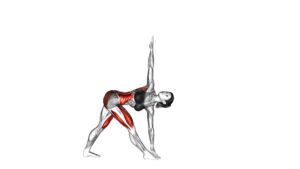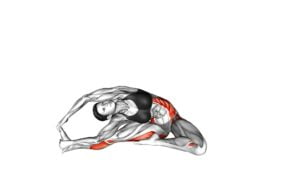Revolved Side Angle Pose (female) – Video Exercise Guide & Tips

Get ready to take your yoga practice to the next level with our video exercise guide for the Revolved Side Angle Pose.
Watch This Exercise Video
In this guide, you'll find step-by-step instructions, common mistakes to avoid, modifications for all levels, and tips to deepen your practice.
Whether you're a beginner or an experienced yogi, this pose will challenge and strengthen your body while improving flexibility and balance.
So grab your mat and let's get started!
Key Takeaways
- Revolved Side Angle Pose improves digestion and alleviates digestive issues such as bloating and constipation.
- The pose increases spinal flexibility and releases tension, improving range of motion in the back.
- Practicing this pose promotes overall well-being and can be customized to suit individual needs and abilities.
- To deepen the practice, focus on breath, use props for support, and enhance mindfulness and awareness through conscious breathing.
Benefits of Revolved Side Angle Pose
Discover the numerous benefits you can experience by practicing Revolved Side Angle Pose. This powerful yoga pose offers a range of advantages, including improved digestion and increased spinal flexibility. Engaging in this pose regularly can have a positive impact on your overall well-being.
One of the notable benefits of Revolved Side Angle Pose is its ability to improve digestion. The twisting motion involved in this pose stimulates the abdominal organs, enhancing their functionality and promoting better digestion. By incorporating this pose into your yoga practice, you can alleviate digestive issues such as bloating and constipation.
In addition to improving digestion, Revolved Side Angle Pose also increases spinal flexibility. As you twist your torso and reach your arm towards the opposite knee, you stretch and lengthen the muscles along your spine. This helps to release tension and improve the range of motion in your back, promoting a healthy and flexible spine.
Now that you're aware of the benefits of Revolved Side Angle Pose, let's move on to the step-by-step guide on how to perform the pose.
Step-by-Step Guide to Performing the Pose
To perform Revolved Side Angle Pose, follow these step-by-step instructions:
- Start in a standing position with your feet hip-width apart. Take a deep breath in and exhale to ground yourself.
- Step your left foot back, keeping it parallel to the front of the mat. Bend your right knee, making sure it stays directly above your ankle.
- Place your left hand on the outside of your right foot, fingers pointing towards the front of the mat. Extend your right arm up towards the ceiling, palm facing forward.
- Twist your torso to the right, bringing your right shoulder towards your left knee. Keep your gaze on your right hand and maintain a strong core.
Proper alignment in revolved side angle pose is crucial to avoid strain or injury. Keep your knees in line with your ankles, and your hips squared to the front of the mat. Engage your core muscles to support your spine and maintain stability.
Breath awareness in revolved side angle pose is important for maintaining focus and relaxation. Take slow, deep breaths throughout the pose, inhaling to lengthen your spine, and exhaling to deepen the twist. Allow your breath to guide you deeper into the pose, while staying mindful of any tension or discomfort.
Remember to listen to your body and modify the pose as needed. With practice and patience, you'll gradually improve your alignment and breath awareness in revolved side angle pose.
Common Mistakes to Avoid
One common mistake to avoid in Revolved Side Angle Pose is collapsing the chest. Proper alignment is essential for this pose to be effective and safe. When you collapse your chest, you aren't fully engaging your core muscles and may experience strain in your lower back.
To avoid this mistake, focus on lengthening your spine and lifting your chest. Imagine a string gently pulling the crown of your head towards the ceiling. This will help you maintain a tall and straight posture.
Additionally, be mindful of your shoulders. Avoid rounding them forward or hunching them up towards your ears. Instead, roll your shoulders back and down, opening up your chest and creating space for your breath.
Modifications and Variations for All Levels
To modify and vary the intensity of Revolved Side Angle Pose for all levels, you can incorporate different props and adjust the depth of the twist. These modifications and progressions will allow you to customize the pose to suit your individual needs and abilities.
Here are four ways to modify and vary Revolved Side Angle Pose:
- Use a yoga block: Place a block under your bottom hand to provide support and stability. This can help you maintain balance and prevent strain in your lower back.
- Modify the leg position: If you find it challenging to keep your back leg straight, you can bend your knee and place your foot on the ground. This will reduce the demands on your leg muscles and allow you to focus more on the twist.
- Use a strap: If you struggle to reach your top arm behind your back, you can use a strap to hold onto instead. This will help you maintain the twist and open up your shoulders.
- Adjust the depth of the twist: If you're a beginner, you can start with a gentle twist by keeping your chest facing forward. As you become more comfortable, you can deepen the twist by rotating your chest towards the sky.
Tips for Deepening Your Practice
Now let's explore how you can deepen your practice of Revolved Side Angle Pose.
One way to enhance your practice is by focusing on your breath. Breathing techniques, such as deep belly breathing and alternate nostril breathing, can help enhance mindfulness and bring a sense of calmness and focus to your practice. By consciously inhaling and exhaling, you can create a deeper connection between your mind and body, allowing you to move more mindfully and with greater awareness.
Another tip for deepening your practice is to incorporate props for added support. Props such as blocks, straps, and blankets can help you modify the pose to suit your individual needs and abilities. For example, using a block can help bring the ground closer to your hands, making it easier to maintain balance in the pose. A strap can be used to gently deepen the twist by providing support for your arms. And a blanket can be placed under your knee for added cushioning and support.
Frequently Asked Questions
How Does Revolved Side Angle Pose Benefit the Digestive System?
Revolved Side Angle Pose can greatly benefit your digestive system.
By twisting your torso and engaging your abdominal muscles, this pose stimulates the organs involved in digestion, such as the stomach and intestines.
This increased blood flow and gentle compression can help improve digestion and relieve bloating or constipation.
Additionally, the stretch and strengthening of the muscles in the abdomen and hips can lead to increased flexibility, further enhancing your overall digestive health.
Can Revolved Side Angle Pose Help With Lower Back Pain?
Revolved side angle pose can certainly help with lower back pain. By gently stretching and strengthening your back muscles, this pose can provide relief and improve flexibility. It also helps to open up the chest and hips, promoting better alignment and posture.
Additionally, there are variations of this pose that you can explore to target specific areas of your lower back. Incorporating revolved side angle pose into your regular yoga practice can be beneficial for alleviating lower back pain.
Should I Avoid This Pose if I Have a Shoulder Injury?
To avoid injury and protect your shoulder, you should modify or avoid the Revolved Side Angle Pose if you have a shoulder injury. This pose requires a deep rotation of the shoulder joint, which can put strain on the injured area.
Instead, focus on poses that promote shoulder stability and strength without excessive rotation. It's important to listen to your body and consult with a healthcare professional or yoga instructor for appropriate modifications.
Can Revolved Side Angle Pose Improve Balance and Stability?
Improving balance and stability can be achieved through practicing Revolved Side Angle Pose. This pose challenges your body to maintain stability while twisting, which helps to enhance your overall balance.
Additionally, it engages the core muscles, improving flexibility and strengthening the core.
Are There Any Precautions or Contraindications for Practicing This Pose?
Before attempting the Revolved Side Angle Pose, it's important to be aware of any precautions or contraindications that may apply to you. This pose involves a twist and can put strain on the spine and knees. If you have any existing injuries or conditions in these areas, it's best to consult with a healthcare professional before practicing this pose.
Additionally, if you're pregnant, it's advisable to avoid this pose as it can be challenging and may not be suitable for your changing body.
Conclusion
In conclusion, the revolved side angle pose is a beneficial yoga posture that helps improve strength, flexibility, and balance. By following the step-by-step guide and avoiding common mistakes, anyone can perform this pose safely.
Modifications and variations are available for all levels, allowing individuals to tailor the practice to their needs. Remember to always listen to your body and gradually deepen your practice over time.
Keep practicing and enjoy the benefits of this empowering yoga pose.

Author
Years ago, the spark of my life’s passion ignited in my mind the moment I stepped into the local gym for the first time. The inaugural bead of perspiration, the initial endeavor, the very first surge of endorphins, and a sense of pride that washed over me post-workout marked the beginning of my deep-seated interest in strength sports, fitness, and sports nutrition. This very curiosity blossomed rapidly into a profound fascination, propelling me to earn a Master’s degree in Physical Education from the Academy of Physical Education in Krakow, followed by a Sports Manager diploma from the Jagiellonian University. My journey of growth led me to gain more specialized qualifications, such as being a certified personal trainer with a focus on sports dietetics, a lifeguard, and an instructor for wellness and corrective gymnastics. Theoretical knowledge paired seamlessly with practical experience, reinforcing my belief that the transformation of individuals under my guidance was also a reflection of my personal growth. This belief holds true even today. Each day, I strive to push the boundaries and explore new realms. These realms gently elevate me to greater heights. The unique combination of passion for my field and the continuous quest for growth fuels my drive to break new ground.







